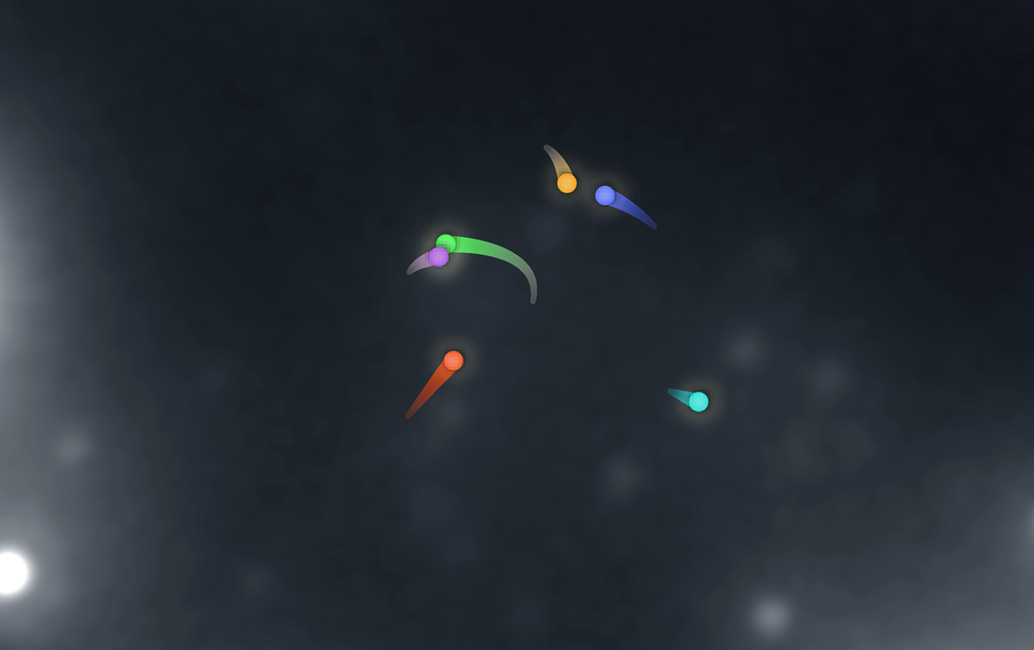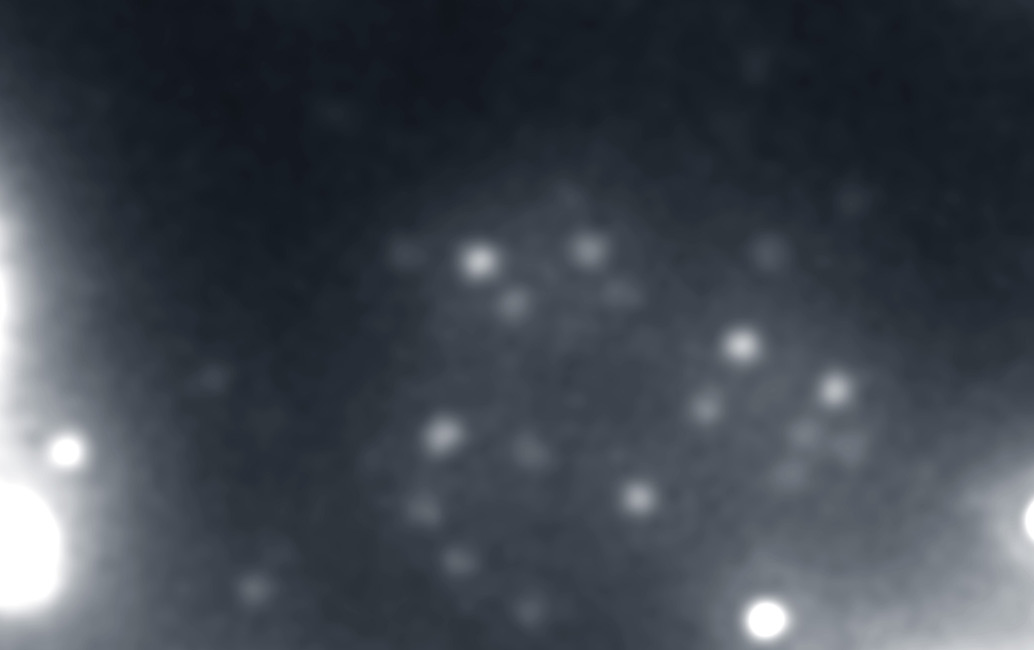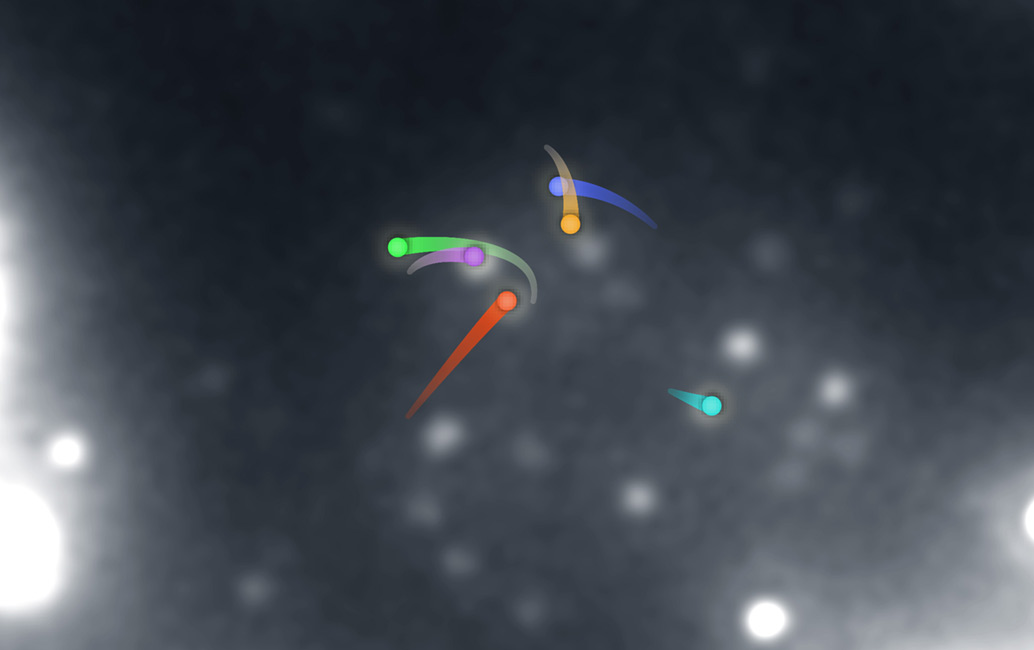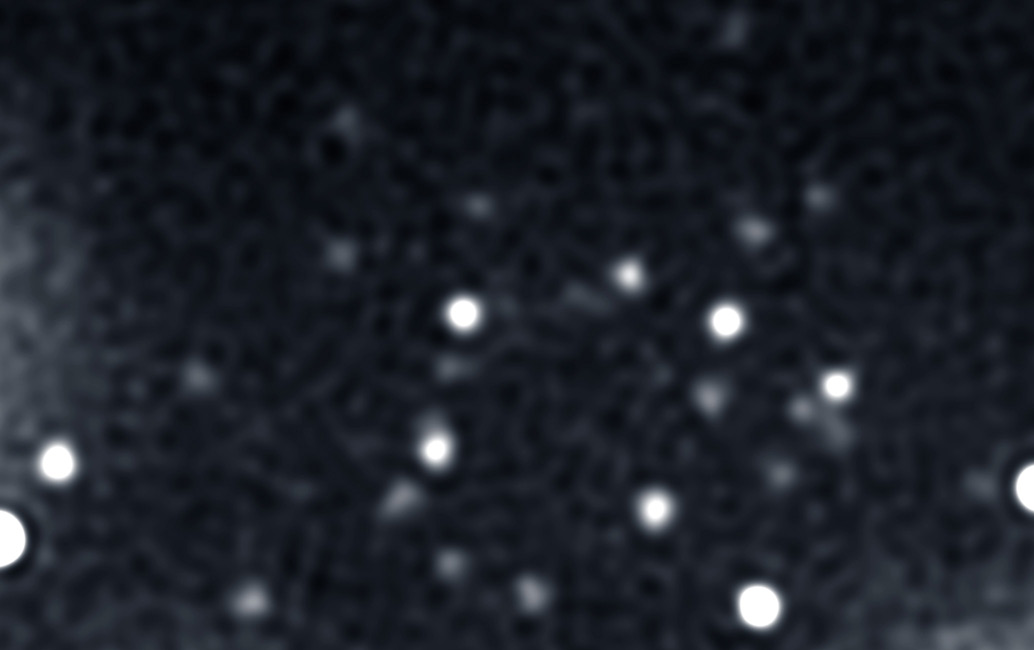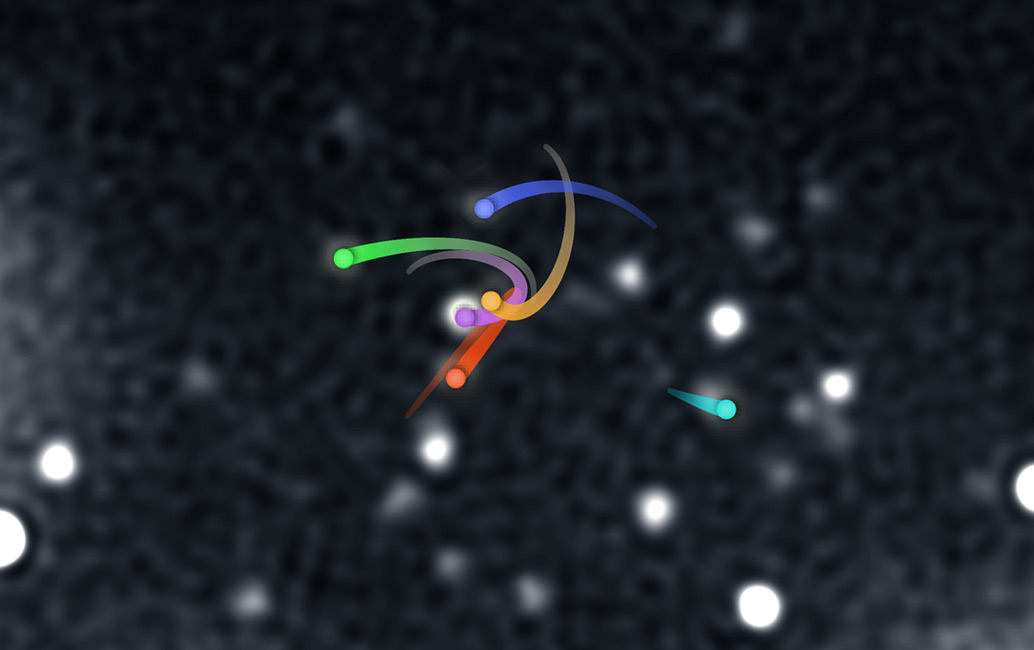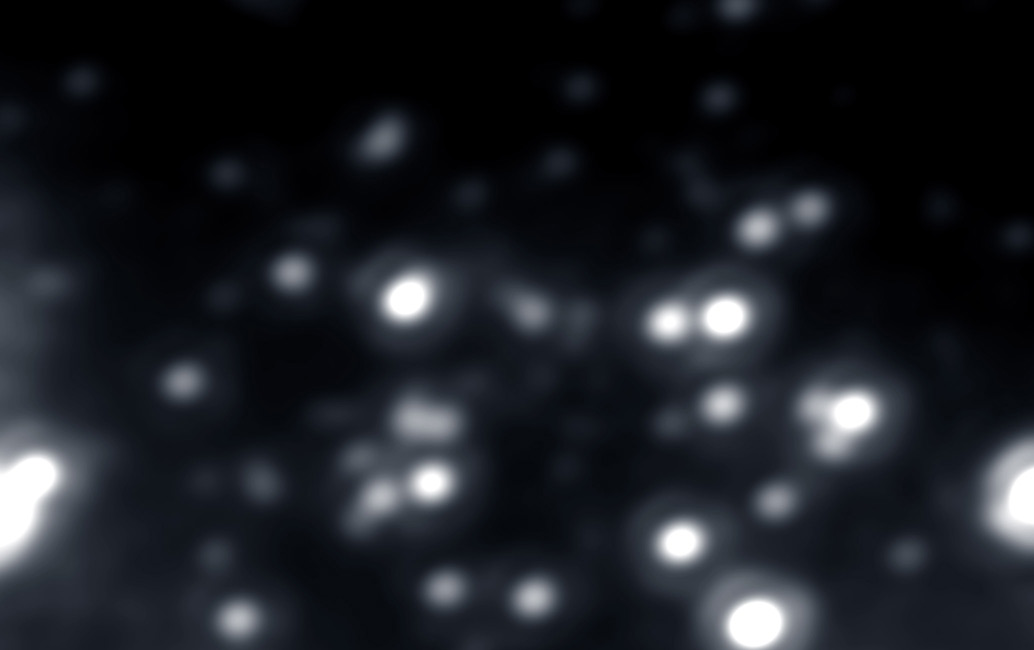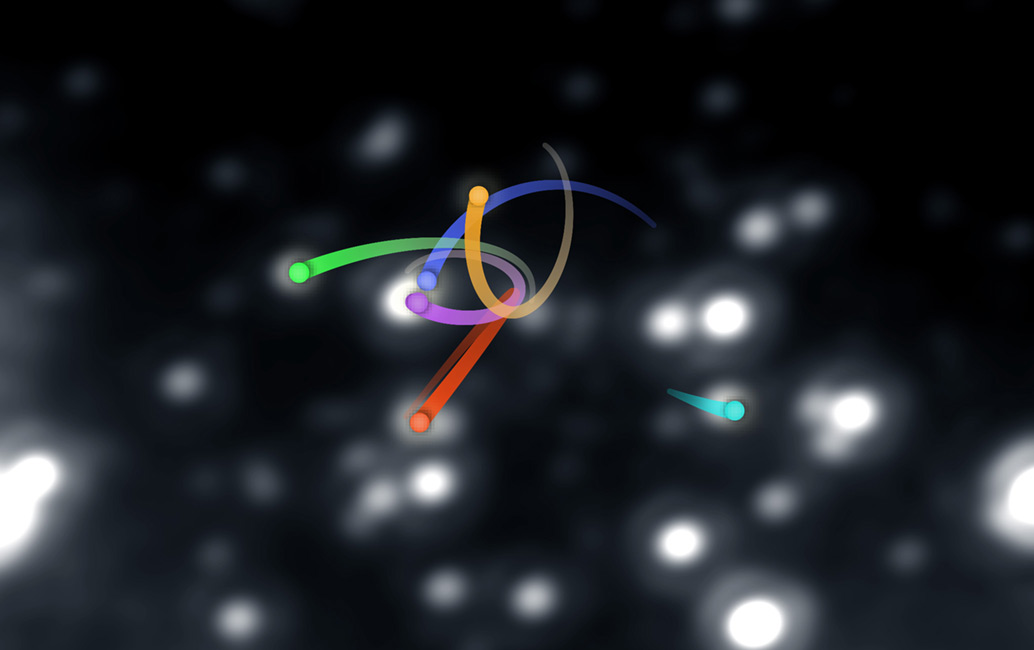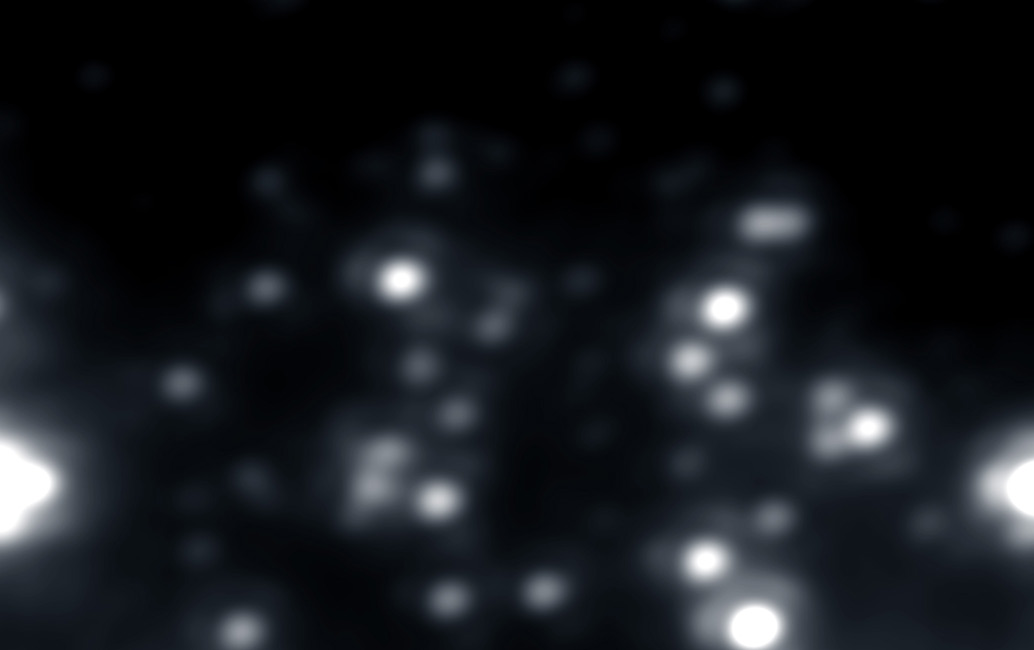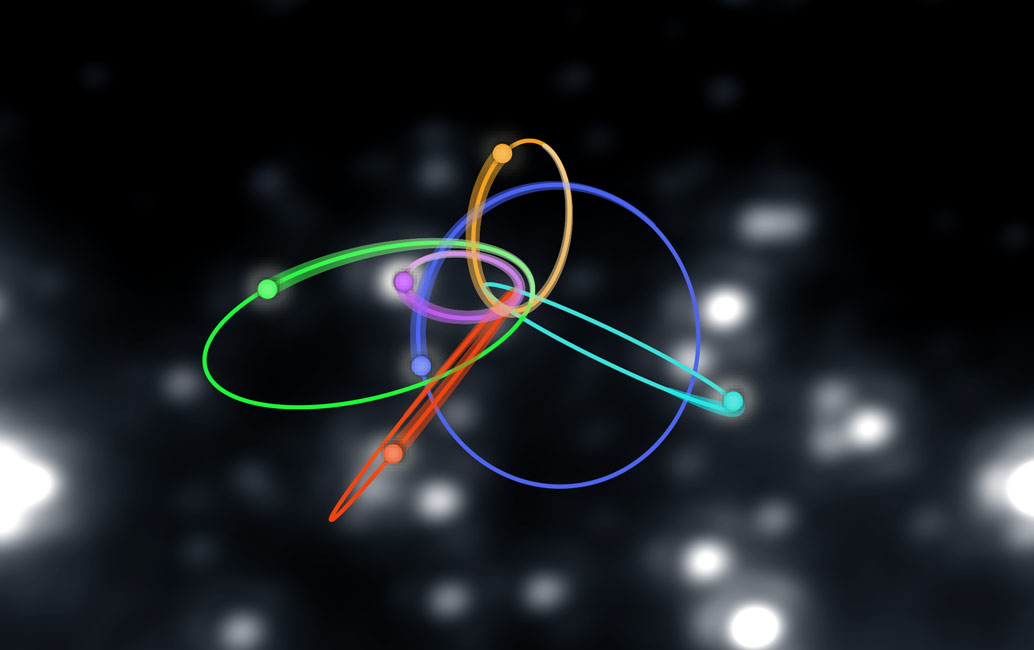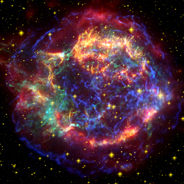Interactive Overview
Slider Interactive: A series of images showing stars located near the center of the Milky Way galaxy. Below the caption is a horizontal slider bar with five labeled stops and a solid white circle. Dragging the white circle right and left along the slider bar causes the image, labels, and caption to change. The change occurs gradually as one image, along with its associated captions and labels, fades out and the next fades in. A toggle button to the upper right of the image turns the image labels off and on. Labels are in the form of text with arrows pointing to specific features in the image. Other labels are graphic overlays.
Slider Stops
From left to right, the slider stops are labeled: 1998, 2000, 2003, 2006, and 2009.
Summary of Slider Stops
Sliding left to right reveals the following:
- “1998” stop shows a low-resolution image of the center of the Milky Way galaxy, with very faint white splotches scattered across. This is the initial image shown when the interactive is loaded.
- “2000” stop shows the same field of view, with some of the white, blurry splotches slightly shifting in different directions among a hazy environment.
- “2003” stop shows the same field of view, with some of the blotches noticeably changing their respective positions and forming arcs relative to their starting positions. The contrast between the white splotches and the background has increased and the surrounding haze has decreased.
- “2006” stop shows the same field of view, with some of the white splotches shifting their respective positions to form incomplete circuit-like arcs compared to their starting positions. They now have halos and the background is more solidly dark.
- “2009” stop shows the same field of view. Some of the white splotches have changed their location against the dark background.
Stop 1: 1998
Image Description: 1998
Image of a dark swath of space. Areas toward the left and right appear slightly lighter—with a gray-white fuzzy glow—than the areas toward the top and bottom of the image. Blurry, faint white blobs of differing definition, which are stars, are scattered toward the center. There is a bright white circle, partially cut off, in the bottom left corner.
Labels: 1998
There are two text labels and six graphic overlays. Six of the blurry gray blobs near the center are each overlaid with a small dot and a simplified comet-like tail, which vary in length and orientation. Each of the six overlays are also unique in color (starting at the top and moving clockwise): orange, blue, cyan, red, purple, and green. The area near the highlighted blobs at the top is labeled “Early observations of stars.” The dark area below the six stars is labeled “Center of our Milky Way galaxy.”
Caption: 1998
As late as the 1990s, it was theorized that a supermassive black hole was at the center of the Milky Way—but unproven.
Stop 2: 2000
Image Description: 2000
This image reveals the same swath of space, now seen in 2000. Some of the objects seen in the prior stop, including the six stars that are depicted as gray blobs, have changed their respective locations. The fuzzy dots lie against a background that has a gray-white glow. Some of the gray blobs seen in the prior stop have become whiter and larger, while new blobs—some white and others gray—appear scattered in the image.
Labels: 2000
There is one text label and six graphic overlays. The six blurry gray blobs that were overlaid with small colorful dots and simplified comet-like tails in the prior stop, are still seen here. The tails still end in the same locations as in the prior stop, but the dots appear to have moved forward, extending the overall length of the tails. The tails show the past locations of the stars and the dots show the current location of the stars. The top center area, where a majority of these graphic overlays appear, is labeled “New star locations.”
Caption: 2000
To find evidence, astronomers began by observing the Milky Way center regularly, identifying individual stars and their orbits.
Stop 3: 2003
Image Description: 2003
This image reveals the same swath of space, now seen in 2003. Some of the objects seen in the prior stops, including the six stars that are depicted as gray blobs, have changed their respective locations. The gray-white fuzzy glow of the background that was visible in the prior two stops has almost disappeared in the 2003 view. A few of the blurry white blobs have increased in brightness and opaqueness, while others remain a dull gray.
Labels: 2003
There is one text label and six graphic overlays. The six blurry gray blobs that were overlaid with small colorful dots and simplified comet-like tails in the prior stop, are still seen here in different locations and with longer, curved tails. The purple star, which was moving to the right has curved back to the left, completing 2/3 of an ellipse. Similarly, the orange star was moving down but has curved back up, completing about half of an ellipse. The red star, which was moving up and to the right, curved sharply back and is now moving down and to the left. The top center area, where a majority of these graphic overlays appear, is labeled “Stars’ orbits become clearer.”
Caption: 2003
As the stars’ orbits became more defined, researchers began theorizing about the Milky Way center: What do the stars point to?
Stop 4: 2006
Image Description: 2006
This image reveals the same swath of space, now seen in 2006. Some of the objects seen in the prior stops, including the six stars that are depicted as gray blobs, have changed their respective locations. The dark swath of space is more solid in color, and the blurry white blobs have increased in size, brightness, and opaqueness. Many of the dots have surrounding light gray halos. Faint, small gray blobs appear scattered throughout the image.
Labels: 2006
There are two text labels and six graphic overlays. The six blurry gray blobs that were overlaid with small colorful dots and simplified comet-like tails in the prior stop, are still seen here in different locations and with longer, curved tails. The purple star toward the center left has almost completed a full ellipse. It is labeled “16-year orbit verified.” The cyan star toward the center right has moved only slightly. Its short tail is only very slightly curved, suggesting it has traced only a small section of a much larger ellipse. It is labeled “Undetermined orbit.”
Caption: 2006
Researchers determined that something 4 million times the mass of the Sun is inside these orbits.
Stop 5: 2009
Image Description: 2009
This image reveals the same swath of space, now seen in 2009. Some of the faint, small gray blobs do not appear in this stop. The blurry white blobs continue to appear and some have changed their location.
Labels: 2009
There is one text label and six graphic overlays. The six blurry gray blobs that were overlaid with small colorful dots and simplified comet-like tails in the prior stop are still seen here, but in different locations. Under their tails and dots are thinner lines that trace ovals to form complete elliptical orbits. The oval-shaped elliptical orbits are different lengths and widths for each of the highlighted stars. Some are very thin and some are very wide and almost circular. The purple star’s orbit is the smallest, suggesting it takes the least amount of time to complete an orbit. The blue star’s orbit is the roundest and the largest, suggesting it takes a longer time to complete its orbit. Toward the center, the small area that is inside all of the ellipses is labeled “Supermassive black hole confirmed.”
Caption: 2009
The stars’ orbits provide overwhelming evidence of a supermassive black hole at the center of our galaxy.

